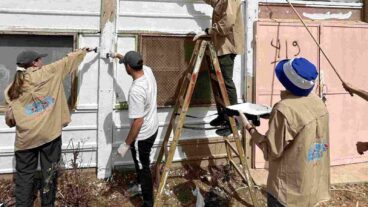Israeli trauma specialist presents groundbreaking nature-based methods at convention of the American Psychological Association in Washington.

Ten years after the World Trade Center towers came crashing down in the historic terror attack that killed thousands of Americans, the consequences and images continue to affect not only survivors and spectators but also the people helping the victims.
How can a caregiver overcome feelings of stress, hopelessness and “compassion fatigue” caused by second-hand trauma?
Guided nature workshops are surprisingly effective, according to Dr. Eleanor Pardess of SELAH-Israel Crisis Management Center, a support organization for victims of trauma within Israel’s immigrant communities.
Pardess and San Francisco-based colleague Dr. Ilene Serlin presented a breakthrough study on care and healing practices for volunteers and professional caregivers at the recent annual convention of the American Psychological Association (APA), the largest association of psychologists worldwide. The study was conducted in cooperation with SELAH.
“Using non-verbal techniques, such as mind-body techniques, is known to be helpful in self-care,” says Pardess, a clinical psychologist who often leads outings for SELAH volunteers to help them recharge their emotional batteries. “We have added a new component of getting into nature and connecting to the natural cycles of change, growth and transformation.”
Trees speak the language of recovery
Israelis’ love of the outdoors sparks appreciation for the power of natural imagery. Trees in particular seem to speak the language of trauma and recovery, Pardess tells ISRAEL21c.
“When you see the regrowth of trees, like after the Carmel forest fire [last December], this enhances hope that there are latent constructive forces of recovery and growth. They may be difficult to see but they are there, and nature provides us endless opportunities to identify those processes of change and regeneration.”

In her doctoral research on secondary trauma, Pardess learned that haunting visual images are stored in the brain in a way that is inaccessible through verbal messages but can be reached through nature and creative or visual art.
“We need a link to these images, and that’s why our workshops go though nature and then creative arts — and then finally meaning-making narrative strategies, the active verbal ingredient in trauma treatment,” says Pardess.
This multimodal, multidisciplinary process is considered mainstream in Israel, she says. “After a terror attack, teachers take out crayons because they know it’s important for children to express themselves through creative means. You can’t talk about it until you create that safe space to talk without being re-traumatized. The use of creative imagery preserves that very important safe space.”
Because this idea is far less familiar elsewhere, conference participants from the US and other countries were eager to learn more. “Many people I spoke to wanted to share their experiences and see how they could incorporate the techniques in medical settings and crisis centers,” says Pardess.
Serlin is organizing an APA trip to Israel for professionals to visit trauma centers, share experiences and learn tools from SELAH to take home. According to Serlin, “Israel is an extremely dynamic, expressive country where the expressive arts and holistic models are well-understood and integrated into treatment approaches to trauma. Its deep and long experience dealing with multigenerational trauma has a great deal to teach us in the United States.”

Nature metaphors, and by extension the SELAH methodology, easily translate to other cultures, says Pardess. “One therapist from Thailand told us how she plans to implement our ideas in work with clients she has been doing in rice fields. She needed a systematic approach to validate and structure what she had already done intuitively.”
Helping ‘wounded healers’
Pardess and Serlin also were asked to provide guidance on long-term support for “wounded healers,” such as Ground Zero firefighters who are themselves survivors.
“Initially, they were praised as heroes but as time went on they felt a lack of validation and they struggle for acknowledgment,” Pardess says. “From a longer-term perspective, their needs must be met medically and communally. When they don’t feel that sense of belonging, there is humiliation and pain.” They discussed the concept of “joy through the lens of a tear,” or nurturing the ability to deal with long-term grief and sorrow while making room for life’s pleasures.
They were also approached for strategies to reach caregivers in minority communities. As a founding member of the Israel Trauma Coalition, SELAH has trained caregivers in disaster zones such as the 2004 school siege in Russia, Hurricane Katrina in New Orleans in 2005 and the Haiti earthquake in 2010.
“Due to Israel’s emphasis on culture and diversity, we understand the importance of mother tongue when reaching out to those in crisis,” says Pardess.
Providing culture-specific help to immigrant populations was SELAH founder Ruth Bar-On’s founding vision. Since 1993, the organization’s volunteers and social workers have aided more than 22,000 immigrants — about 80 percent of them Russian and Ethiopian — following terrorist attacks, traffic or work accidents, sudden serious illness and domestic violence.













